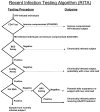Estimating HIV Incidence in Populations Using Tests for Recent Infection: Issues, Challenges and the Way Forward
- PMID: 21743821
- PMCID: PMC3130510
Estimating HIV Incidence in Populations Using Tests for Recent Infection: Issues, Challenges and the Way Forward
Abstract
INTRODUCTION: HIV incidence is the rate of new infections in a population over time. HIV incidence is a critical indicator needed to assess the status and trends of the HIV epidemic in populations and guide and assess the impact of prevention interventions. METHODS: Several methods exist for estimating population-level HIV incidence: direct observation of HIV incidence through longitudinal follow-up of persons at risk for new HIV infection, indirect measurement of HIV incidence using data on HIV prevalence and mortality in a population, and direct measurement of HIV incidence through use of tests for recent infection (TRIs) that can differentiate "recent" from "non-recent" infections based on biomarkers in cross-sectional specimens. Given the limitations in measuring directly observed incidence and the assumptions needed for indirect measurements of incidence, there is an increasing demand for TRIs for HIV incidence surveillance and program monitoring and evaluation purposes. RESULTS: Over ten years since the introduction of the first TRI, a number of low-, middle-, and high-income countries have integrated this method into their HIV surveillance systems to monitor HIV incidence in the population. However, the accuracy of these assays for measuring HIV incidence has been unsatisfactory to date, mainly due to misclassification of chronic infections as recent infection on the assay. To improve the accuracy of TRIs for measuring incidence, countries are recommended to apply case-based adjustments, formula-based adjustments using local correction factors, or laboratory-based adjustment to minimize error related to assay misclassification. Multiple tests may be used in a recent infection testing algorithm (RITA) to obtain more accurate HIV incidence estimates. CONCLUSION: There continues to be a high demand for improved TRIs and RITAs to monitor HIV incidence, determine prevention priorities, and assess impact of interventions. Current TRIs have noted limitations, but with appropriate adjustments, interpreted in parallel with other epidemiologic data, may still provide useful information on new infections in a population. New TRIs and RITAs with improved accuracy and performance are needed and development of these tools should be supported.
Figures


References
-
- Sherr L, Lopman B, Kakowa M, Dube S, Chawira G, Nyamukapa C, et al. Voluntary counselling and testing: uptake, impact on sexual behaviour, and HIV incidence in a rural Zimbabwean cohort. AIDS. 2007;21:851–860. - PubMed
-
- Ades AE. Serial HIV seroprevalence surveys: interpretation, design, and role in HIV/AIDS prediction. J Acquir Immune Defic Syndr Hum Retrovirol. 1995;9:490–499. - PubMed
-
- Ades AE, Medley GF. Estimates of disease incidence in women based on antenatal or neonatal seroprevalence data: HIV in New York City. Stat Med. 1994;13:1881–1894. - PubMed
Grants and funding
LinkOut - more resources
Full Text Sources
